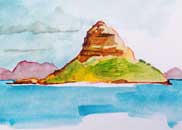"No man is an island unto himself. Every man is a piece of the continent, a part of the main." ~ John Donne
A symbolic part of Hawaiian history and spirituality, Islanders call the small island off Oahu's northeast shore Chinaman's Hat, because of its cone-shaped resemblance to the coolie cap worn on the plantations.
Early Hawaiians called it Mokolii Island, "fin of the lizard," and believed the jutting islet was all that was left of the mo'o (lizard/dragon) slain and hurled into the sea by Hiiaka, the sister of powerful volcano goddess Pele.
Mokolii was believed to be a sacred puu honua, or place of refuge, and ancient canoes passing the island would lower their sails out of respect. Ali'i (royalty) brought their children there to learn the necessary arts and skills to rule.
Today, at low tide, with footwear to walk on the sharp coral, you can swim or wade out to Mokolii, and enjoy its small sandy beach and bird preserve.
This most sacred spot is located about 500 yards off the shore of Kualoa ("long ancestral background") Regional Park, a 150-acre palm-tree fringed peninsula popular for family picnics, snorkeling, and fishing.
Wili wili trees, used for precious jewelry and leis, are ablaze in red in the winter and line the entry way. The park offers magical views of the Koolaus and Kaneohe Bay... Just beautiful.
(Camp and experience being "part of the main." For more information, contact the Honolulu Department of Parks and Recreation, 650 South King Street, Honolulu, Hawaii 96713, 808/523-4325.)
Because of the sacred heritage surrounding Mokolii, time waits, dreams are made, and life reveals its mysteries. "The grand show is eternal," observed conservationist
 No one is an island. We need each other and are a part of each other.
No one is an island. We need each other and are a part of each other.
